 1802. Earl Haddington in morning dress: The boot are 'Hessians', over trousers or pantaloons
with 'small falls'; the waist band of the pants is high, at the 'natural waist',
which is to say at fastening across the navel. The close-fitted jacket is cutaway in a
curve to show the straight edge of the waistcoat sitting just below the waistband of the pants.
It has a high 'M'-notched velvet collar, and six pairs of gilt buttons of which four are
functional. At the front of the right hip a fob hangs on a ribbon, at the other end of which
is a watch in a pocket in the waistband of the pants. Gloves in hand.
1802. Earl Haddington in morning dress: The boot are 'Hessians', over trousers or pantaloons
with 'small falls'; the waist band of the pants is high, at the 'natural waist',
which is to say at fastening across the navel. The close-fitted jacket is cutaway in a
curve to show the straight edge of the waistcoat sitting just below the waistband of the pants.
It has a high 'M'-notched velvet collar, and six pairs of gilt buttons of which four are
functional. At the front of the right hip a fob hangs on a ribbon, at the other end of which
is a watch in a pocket in the waistband of the pants. Gloves in hand.
Dance Kaleidoscope Costume - Portraits and Discussions
By Iain MacPhail
Here are some illustrations gleaned from the Internet. I strongly recommend the Pemberly collection, and Jesamyn's Regency Costume Companion.
 1801. The Duke of Argyll in 'undress': breeches, hose (stockings), low slip-on shoes,
the jacket is open, but otherwise similar to Haddington's. A single breasted waistcoat
with reveres (front corners of the collar cut to lay back). Gloves in hand. Very suitable
for an afternoon of informal dancing with family and friends.
1801. The Duke of Argyll in 'undress': breeches, hose (stockings), low slip-on shoes,
the jacket is open, but otherwise similar to Haddington's. A single breasted waistcoat
with reveres (front corners of the collar cut to lay back). Gloves in hand. Very suitable
for an afternoon of informal dancing with family and friends.
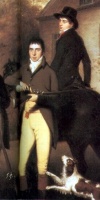 1802. Jesamyn points out that the jacket of the standing Lukin brother is an old-fashioned
style, cutaway in a continuous curve. Breeches were commonly of suede leather, very hard
wearing, quite expensive, and cut quite differently from modern trousers. They are fitted
from below the knee to the lower part of the thigh, with side opening and either buttoned,
buckled or with ties at the lower edge. The upper thigh and seat is quite full, even baggy
behind, allowing a comfortable seat. The fit over the hips is adjusted by lacing or buckled
tabs behind. The high waistband closes in front, under the drop front, or 'falls', with a
watch pocket on the right; the watch fob is the red tab visible in the portrait. The treatment
of the two side closures of the falls varied greatly: small, large, buttons visible or hidden,
plain or decorated.
1802. Jesamyn points out that the jacket of the standing Lukin brother is an old-fashioned
style, cutaway in a continuous curve. Breeches were commonly of suede leather, very hard
wearing, quite expensive, and cut quite differently from modern trousers. They are fitted
from below the knee to the lower part of the thigh, with side opening and either buttoned,
buckled or with ties at the lower edge. The upper thigh and seat is quite full, even baggy
behind, allowing a comfortable seat. The fit over the hips is adjusted by lacing or buckled
tabs behind. The high waistband closes in front, under the drop front, or 'falls', with a
watch pocket on the right; the watch fob is the red tab visible in the portrait. The treatment
of the two side closures of the falls varied greatly: small, large, buttons visible or hidden,
plain or decorated.
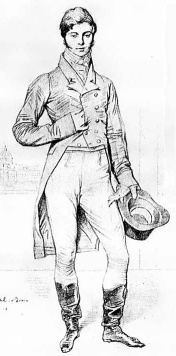 1816. Lord Grantham in morning dress, ready to visit by carriage or on foot; the 'Hessians'
seem too fine for riding. Note particularly how the boots fit the foot very closely, bagging
out in the calf to allow them to be slipped on. The low cut of the boots shows that he is
wearing trousers, or perhaps calf-length pantaloons. Note again how the trousers fit closely
from calf to mid-thigh. Above, they allow room for the family jewels (jocks did not exist,
tailors accommodated natural anatomy, with most men 'dressing to the left'). The baggy seat
to the trousers was hidden by the jacket tails. The jacket is close-fitting, with a high
double-breasted front closure with five pairs of functional buttons. The sleeves are knuckle
length. He carries a top hat and gloves.
1816. Lord Grantham in morning dress, ready to visit by carriage or on foot; the 'Hessians'
seem too fine for riding. Note particularly how the boots fit the foot very closely, bagging
out in the calf to allow them to be slipped on. The low cut of the boots shows that he is
wearing trousers, or perhaps calf-length pantaloons. Note again how the trousers fit closely
from calf to mid-thigh. Above, they allow room for the family jewels (jocks did not exist,
tailors accommodated natural anatomy, with most men 'dressing to the left'). The baggy seat
to the trousers was hidden by the jacket tails. The jacket is close-fitting, with a high
double-breasted front closure with five pairs of functional buttons. The sleeves are knuckle
length. He carries a top hat and gloves.
 Sir Francis Burdett, reformist politician, (see a later portrait below) in romantic pose,
dressed for parliament or any other formal occasion. It appears that the breeches are a
finer material than the jacket, and the stockings are probably silk. The only flash of
colour is in the fob hanging from the watch pocket in the waist band of his breeches.
(See the section 'Gentlemen's Fobs'). Breeches hung on (so to
speak) as court attire among the conservative, timid or uninformed, until late in the century
when at a naval review the Prince of Wales acidly ridiculed the breeches worn by a peer.
Sir Francis Burdett, reformist politician, (see a later portrait below) in romantic pose,
dressed for parliament or any other formal occasion. It appears that the breeches are a
finer material than the jacket, and the stockings are probably silk. The only flash of
colour is in the fob hanging from the watch pocket in the waist band of his breeches.
(See the section 'Gentlemen's Fobs'). Breeches hung on (so to
speak) as court attire among the conservative, timid or uninformed, until late in the century
when at a naval review the Prince of Wales acidly ridiculed the breeches worn by a peer.
 After generations in which the English aped French style, the French adopted the English style
around the time of the Revolution. Only two of the double-breasted jacket's six pairs of
bright buttons are functional (some are obscured by the lapels). The breeches are a
comfortable fit; he 'dresses to the left'. This chap's chosen to be portrayed with tools
in hand, perhaps distinguish himself from the (now mostly shorter) Aristocrats.
Tools or not, the boots are a giveaway. Very fine and close-fitting, they just
wouldn't do for mucking out the byre.
After generations in which the English aped French style, the French adopted the English style
around the time of the Revolution. Only two of the double-breasted jacket's six pairs of
bright buttons are functional (some are obscured by the lapels). The breeches are a
comfortable fit; he 'dresses to the left'. This chap's chosen to be portrayed with tools
in hand, perhaps distinguish himself from the (now mostly shorter) Aristocrats.
Tools or not, the boots are a giveaway. Very fine and close-fitting, they just
wouldn't do for mucking out the byre.
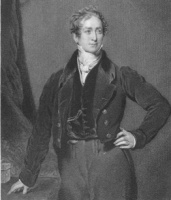
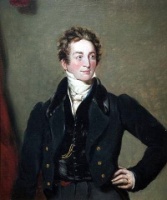 These two etchings from portraits by Sir Thomas Lawrence show the costume detail more clearly
than the coloured versions. The first is Robert Peel, wearing a double-breasted jacket,
casually open. Both jacket collar and waistcoat are in velvet. The founder of the police
force demonstrates a heightened sense of securing one's personal items on the streets of
London. The portrait shows a chain across the waistcoat, presumably to a watch in a vest
pocket, heralding a change in fashion away from the watch fob at the right hip. Below we
can see that the jacket is blue, the trousers grey. The jacket collar and vest are velvet,
and he seems to be wearing a second, white vest.
These two etchings from portraits by Sir Thomas Lawrence show the costume detail more clearly
than the coloured versions. The first is Robert Peel, wearing a double-breasted jacket,
casually open. Both jacket collar and waistcoat are in velvet. The founder of the police
force demonstrates a heightened sense of securing one's personal items on the streets of
London. The portrait shows a chain across the waistcoat, presumably to a watch in a vest
pocket, heralding a change in fashion away from the watch fob at the right hip. Below we
can see that the jacket is blue, the trousers grey. The jacket collar and vest are velvet,
and he seems to be wearing a second, white vest.
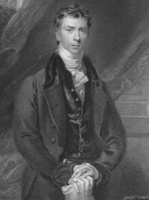
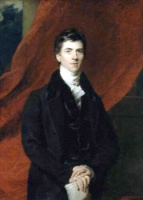 Henry, 1st Baron Brougham and Vaux, 1825. He wears a dark jacket and waistcoat. The buttons
are 'self-covered' (covered with the same material as the jacket). Compare with Robert Peel's
gilt buttons. Although a highly respected reformist politician, the Baron's taste in clothing
remained conservative; a photograph of him as an old man shows him still affecting the
drop-fronted trousers fashionable years earlier.
Henry, 1st Baron Brougham and Vaux, 1825. He wears a dark jacket and waistcoat. The buttons
are 'self-covered' (covered with the same material as the jacket). Compare with Robert Peel's
gilt buttons. Although a highly respected reformist politician, the Baron's taste in clothing
remained conservative; a photograph of him as an old man shows him still affecting the
drop-fronted trousers fashionable years earlier.
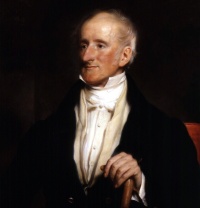 Sir Francis Burdett (see above), older, having lived through interesting times. Radical,
lover, duellist, his story makes interesting reading.
Sir Francis Burdett (see above), older, having lived through interesting times. Radical,
lover, duellist, his story makes interesting reading.
 1807. A fashion plate. Dressed for an evening in company, he wears buff breeches with white
hose and low-cut flat shoes with a bow. Under his arm he carries a collapsible bicorn hat.
His companion is dressed in high Empire style.
1807. A fashion plate. Dressed for an evening in company, he wears buff breeches with white
hose and low-cut flat shoes with a bow. Under his arm he carries a collapsible bicorn hat.
His companion is dressed in high Empire style.
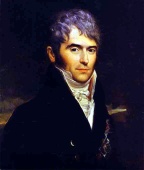 With perfect taste this gentleman turns the right shoulder to the portraitist,
thus partially hiding the elaborate 'orders' on his left breast.
With perfect taste this gentleman turns the right shoulder to the portraitist,
thus partially hiding the elaborate 'orders' on his left breast.
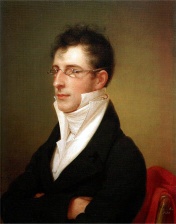 Rubens Peale was an American artist and museum director. His portrayal with spectacles has
excited considerable discussion. Until this research, I hadn't thought of the Americans
as Regency types; there are more below.
Rubens Peale was an American artist and museum director. His portrayal with spectacles has
excited considerable discussion. Until this research, I hadn't thought of the Americans
as Regency types; there are more below.
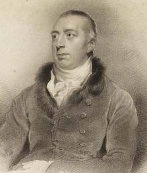 Richard Payne Knight, classical scholar and connoisseur. The informal velvet house coat
or 'frock' with the fur collar is what we might call a dressing-gown. He was not always
portrayed with such close-cropped hair.
Richard Payne Knight, classical scholar and connoisseur. The informal velvet house coat
or 'frock' with the fur collar is what we might call a dressing-gown. He was not always
portrayed with such close-cropped hair.
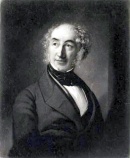 Sir William J Hooker, first director of the Royal Botanic Gardens at Kew. The black neckcloth
may be a 'stock', which is to say 'made-up' neckwear on a stiffened base material, buttoning
at the back. Much favoured by the military and anyone else who didn't want to fuss.
Sir William J Hooker, first director of the Royal Botanic Gardens at Kew. The black neckcloth
may be a 'stock', which is to say 'made-up' neckwear on a stiffened base material, buttoning
at the back. Much favoured by the military and anyone else who didn't want to fuss.
